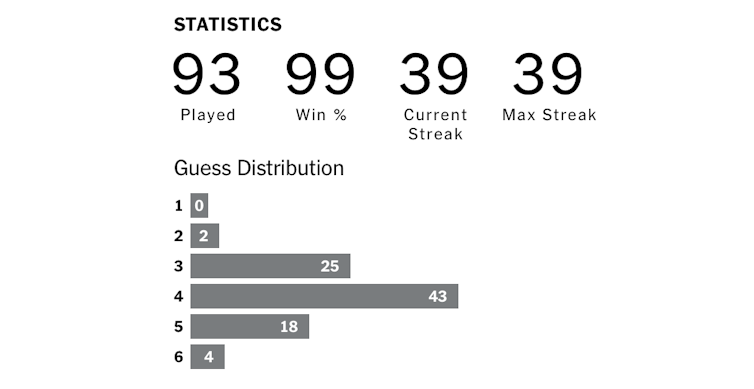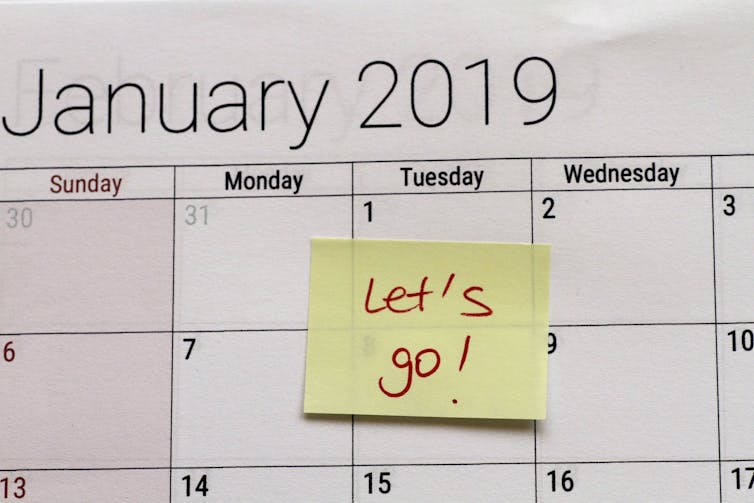Keeping a streak alive can be strong motivation to stick with a chosen activity
Jan 01, 2024 10:34AM ● By Content Editor
By Danny Weathers, Professor of Marketing, Clemson University - The Conversation - January 1, 2024
Dick Coffee attended 781 consecutive University of Alabama football games. Meg Roh surfed through illness, storms and nightfall to maintain a seven-year daily surfing streak. Jon Sutherland ran at least 1 mile every day for over 52 years.
An activity streak has the power to compel behavior, and marketers have taken note. Marketing researchers Jackie Silverman and Alixandra Barasch recently documented 101 unique instances, including Snapchat, Candy Crush Saga, Wordle and the Duolingo language learning platform, of apps that have incorporated streaks into their architecture by tracking the number of consecutive days users complete a task. There are even apps dedicated solely to tracking streaks.

What is it about streaks that makes them so compelling? I’m interested in consumer behavior and decision making. For insight into streaks and their motivating influence, I conducted research, recently published in the Journal of the Academy of Marketing Science, on the phenomenon.
What is a streak?
Because there’s no generally accepted definition of what a streak is, I started by trying to define the phenomenon. Based on input from people maintaining streaks and how streaks are described in the popular media, I suggest they have four underlying characteristics.
First, streaks require unchanging performance and temporal parameters. In other words, rules, established by the streaker or others, define what it means to successfully complete the activity and the schedule for doing so. For example, a streak may involve completing a session of 50 pushups every calendar day.
Second, the streak-holder largely attributes completing the activity to his or her resolve.
Third, a streak is a series of the same completed activity that the person maintaining the streak considers to be uninterrupted.
Fourth, the streaker quantifies the series’ duration. For instance, a streak-holder can tell you exactly how many consecutive workdays they’ve biked in to the office, or they can tell you the precise date the streak began.
This definition distinguishes an activity streak from winning streaks and lucky streaks. Unlike activity streaks, winning streaks depend on the performance of others – an opponent – while lucky streaks involve outcomes that are not under the control of the person executing the streak.
My definition also highlights that streaks are perceptual. Some people who have completed an objectively uninterrupted series of an activity may not view that as a streak. Others who have not completed the activity every time the opportunity arises may believe they have a streak.
Is it a streak, habit or collection?
People often engage in behavior patterns, or a recurring way of acting in a given situation. A streak is a form of patterned behavior, but there are others. Most people have habits, which are reflexlike and triggered by the context. For example, many people mindlessly fasten their seat belts upon getting in a car.
That automatic aspect sets a habit apart from a streak. A streak often requires the actor to have a strategy for completing the activity in various situations or contexts. For example, someone with a streak of running at least 1 mile every calendar day may need to carefully plan a run when traveling across time zones.

While developing a habit may be appealing because it minimizes thinking, I discovered that the challenge of finding a way to complete the behavior can motivate many streak-holders.
Failing to perform a habitual behavior on occasion will have little impact on the likelihood of the person performing the behavior in the future. Conversely, failing to perform a behavior that is part of a streak ends the streak.
For some people, ending a streak discouraged the behavior in the future: “The streak is over. Why bother?” For others, it hardened their resolve: “The streak is over. I’ve got to start another streak as soon as possible.”
Creating a collection is another form of patterned behavior. Collections typically involve dissimilar objects connected by a common meaning. For example, Jay Leno is known for his collection of antique and exotic cars. But unlike a streak, a collection does not end if someone fails to add to it every time the opportunity arises. I found that a collection of experiences or stories is often a byproduct of maintaining a streak.
Why do streaks motivate behavior?
By tapping into various psychological drivers of behavior, streaks can motivate people in several ways.
In general, a streak adds a higher-level goal (keeping the streak alive) to a lower-level goal (completing an individual activity). Streaks also add structure to an activity, and structure can simplify thinking and decision making. The extent to which goal achievement or structure is important to you would influence your commitment to a streak.
I also found the way a streak is structured can affect the streak-holder’s commitment to it. For example, a streak of meditating at least 20 minutes each day may be more appealing, and lead to more commitment, than a streak of meditating at least 140 minutes each week. While the amount of meditating is the same in both cases, a daily streak adds structure, thus simplifying decision making, and encourages the person to regularly engage in a beneficial behavior.
Streaks can serve to gamify the underlying activity by creating rules and quantifying the outcome, and many people enjoy the challenge of a game.
Finally, I found that activities that are more relevant to one’s identity are more likely to generate commitment to a streak. If someone identifies as religious, a daily streak of praying may be more appealing than a daily streak of playing Wordle because a praying streak can provide a way of demonstrating one’s desired identity to others.
While streaks can compel behavior, they do not motivate all people for all situations. They can even have the opposite effect. Some people are turned off by the prospect of a streak because they’re concerned about being obligated to it, as reflected in the comments of a former streak runner: “I realized that, if I let it, the streak could become a ‘thing’ that controlled my life, my travel, and those around me.”

Streaks and the new year
As the calendar turns to a new year, many people resolve to engage in self-improving behaviors that facilitate better mental or physical health. People often begin streaks on Jan. 1 or other important dates, such as holidays, birthdays or anniversaries of noteworthy events. Such temporal landmarks add meaning and structure to the streak and create a “fresh start effect.”
While many people make New Year’s resolutions, only a small percentage of people complete them. My research suggests that structuring a resolution as a streak may be the nudge that some people need to stick with it further into the new year – and maybe far beyond.
To view the original story, visit The Conversation site here.

